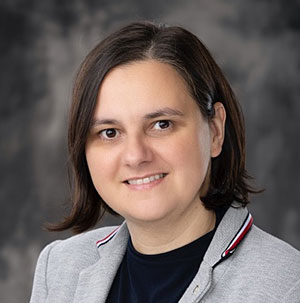UM Earns Research Award for Submicroscopic 3D Printer
 MISSOULA – A University of Montana research center recently was awarded a $480,000 grant to support the purchase of a three-dimensional bioprinter, which will allow nanofabrication of tiny structures.
MISSOULA – A University of Montana research center recently was awarded a $480,000 grant to support the purchase of a three-dimensional bioprinter, which will allow nanofabrication of tiny structures.
The new instrument, only the second such bioprinter at a U.S. university, will add a submicroscopic dimension to UM’s technological toolkit.
The M.J. Murdock Charitable Trust grant went to the University’s Montana Biotechnology Center (BIOTECH). The funding will purchase a highly precise bioprinter, the Quantum X Bio System, which can construct sub-microscale tissue-like structures from biomaterials, tiny drug delivery systems, sensors and more.

“The Quantum X Bio System will accentuate the cutting-edge educational and research capabilities of our center and UM,” said Monica Serban, the BIOTECH director. “It also will strengthen our clinical, academic and corporate partnerships and allow our students to be involved in solving real-life biomedical and biotechnological societal problems – involving them in open innovation and prototyping.”
How exciting is the new bioprinter? Well, it uses laser-writing technology to create incredibly tiny structures at tremendous speed and accuracy for biological and biomedical applications. It uses something called “two-photon polymerization” for its sub-microscale 3D printing, a process that relies on the super-accurate interaction of light with a photosensitive material, which then becomes a building block for the printed structure.
In her own research, Serban will use the bioprinter to develop a prototype device that instantly releases hearing-protective therapeutics when it detects harmful noise levels. This could protect the hearing of U.S. military personnel. In fact, the bioprinter purchase will be jointly funded by her Office of Naval Research project titled “New Engineered Systems to Prevent Hearing Loss in Sailors and Marines.”
BIOTECH is focused on connecting students, entrepreneurs, scientists and clinicians so they can enhance local and regional biotechnology capabilities. Its mission is to enable local and regional biotechnology-focused workforce development through educational activities. It does research that targets the development of biomedical products – specifically therapeutics, wearable sensors and other medical devices intended primarily for resource-limited settings.

“We are extremely grateful for our sponsors’ support and are excited to share the 3D bioprinter’s capabilities and associated scientific outcomes with our valued research community,” said Heidi Boggs, associate director of the UM center. “At BIOTECH we are passionate about growing innovative research technologies that will improve our way of life and benefit society. This instrument provides research, innovation and partnership opportunities otherwise not possible.”
One example of such a partnership is BIOTECH’s collaboration with Dr. Rob Minor of Billings Clinic Heart and Vascular at Community Medical Center in Missoula. Minor hopes to use the Quantum X Bio System to create patient-specific 3D models of vascular anatomy. This will enable pre-surgical blood-vessel-stenting procedure simulations for difficult cases, as well as the development and testing of innovative therapies.
Minor also is involved in the development of Montana’s first Center for Critical Limb Ischemia Care and Limb Salvage. This new center seeks to provide expanded services to all western Montana, with the goal of preventing amputations and improving quality of life.
“The center would link vascular specialists, multidisciplinary team members and wound care services with many rural Montana communities,” said Minor, an interventional cardiologist. “This will create additional collaborative opportunities with BIOTECH through which our students and researchers could learn of current unmet needs and challenges in healing chronically infected wounds and those that lack blood supply. It could apply the bioprinter’s unique capabilities to novel therapeutic alternatives.”
Scott Whittenburg, UM vice president for research and creative scholarship, said the new bioprinter will be a welcome addition to the University’s research enterprise.
“As a top-tier R1 research university, UM needs more tools like this that advance our abilities to work in emerging scientific fields,” Whittenburg said. “Once the bioprinter is installed, it will be only the second Quantum X instrument in the U.S., with the other housed at Rice University in Houston.
“Not only is this instrument the centerpiece of our array of advanced 3D printing technologies, it will lead to collaborations with researchers at other institutions regionally and nationally,” he said.
The M.J. Murdock Charitable Trust, created by the will of the late Melvin J. “Jack” Murdock, provides grants to nonprofit organizations in five states of the Pacific Northwest –Alaska, Idaho, Montana, Oregon and Washington. The trust seeks to strengthen the region’s educational, social, spiritual and cultural base in creative and sustainable ways.
###
Contact: Monica Serban, director, UM Montana Biotechnology Center, 406-243-4907, monica.serban@umontana.edu; Heidi Boggs, BIOTECH associate director, 406-243-2225, heidi.boggs@umontana.edu.